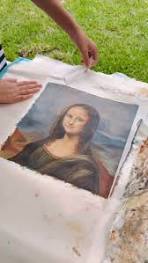The Enigmatic Smile: Unraveling the Mystery of the Mona Lisa Painting
One of the most iconic and enigmatic works of art in history, the Mona Lisa painting by Leonardo da Vinci continues to captivate audiences around the world with its mysterious smile and timeless beauty.
Painted between 1503 and 1506, the Mona Lisa is a portrait of Lisa Gherardini, a Florentine woman believed to be the wife of a wealthy merchant. What sets this painting apart is not just its subject matter, but also the artist’s masterful technique and attention to detail.
Leonardo da Vinci employed a groundbreaking painting style known as sfumato, which creates a soft, blurred effect that enhances the realism of the portrait. The subtle gradations of light and shadow give life to the figure, making it appear almost three-dimensional.
However, it is perhaps the subject’s enigmatic smile that has sparked endless speculation and debate among art historians and enthusiasts. Is she smiling or merely posing? What secrets lie behind that elusive expression?
Some believe that the smile is a reflection of Leonardo’s own sense of humor and wit, while others suggest that it conveys deeper emotions or hidden meanings. The ambiguity of the smile adds to the painting’s intrigue and has inspired countless interpretations over the centuries.
Today, the Mona Lisa hangs in the Louvre Museum in Paris, where it attracts millions of visitors each year who come to marvel at its beauty and ponder its mysteries. Despite being over 500 years old, this masterpiece continues to resonate with audiences and remains a symbol of artistic excellence and creative genius.
Whether you see her as a symbol of beauty, mystery, or both, there is no denying the enduring allure of the Mona Lisa painting—a timeless masterpiece that transcends time and culture.
6 Fascinating Facts About Leonardo da Vinci’s Iconic Mona Lisa Painting
- The Mona Lisa was painted by Leonardo da Vinci in the early 16th century.
- It is one of the most famous paintings in the world, known for the enigmatic smile of the subject.
- The painting is housed in the Louvre Museum in Paris, France.
- Mona Lisa’s eyes appear to follow you as you move around the room, a technique known as ‘sfumato.’
- Leonardo da Vinci used a combination of oil and tempera paints to create the masterpiece.
- The Mona Lisa has been stolen twice, once in 1911 and again in 1974, but it was recovered both times.
The Mona Lisa was painted by Leonardo da Vinci in the early 16th century.
The Mona Lisa, a renowned masterpiece, was skillfully painted by the legendary artist Leonardo da Vinci during the early 16th century. Leonardo’s meticulous brushwork and innovative techniques brought to life the captivating portrait of Lisa Gherardini, immortalizing her enigmatic smile for generations to come. This iconic painting continues to fascinate art lovers worldwide with its timeless beauty and unparalleled artistry, solidifying Leonardo da Vinci’s legacy as one of the greatest artists in history.
It is one of the most famous paintings in the world, known for the enigmatic smile of the subject.
The Mona Lisa painting is renowned as one of the most famous artworks globally, celebrated for the captivating and enigmatic smile depicted on the subject’s face.
The painting is housed in the Louvre Museum in Paris, France.
The Mona Lisa painting, one of the most renowned artworks in history, is housed within the prestigious walls of the Louvre Museum in Paris, France. As a cultural icon and a symbol of artistic mastery, the painting attracts visitors from all corners of the globe who flock to the museum to witness its enigmatic beauty firsthand. Displayed in a carefully curated setting, the Mona Lisa continues to captivate art enthusiasts and historians with its timeless allure and mysterious charm, making it a must-see masterpiece for anyone exploring the rich tapestry of art history at the Louvre.
Mona Lisa’s eyes appear to follow you as you move around the room, a technique known as ‘sfumato.’
In the iconic Mona Lisa painting, viewers often experience the sensation that her eyes are following them as they move around the room. This mesmerizing effect is achieved through Leonardo da Vinci’s innovative painting technique called ‘sfumato,’ which creates a subtle blending of colors and tones to give the illusion of depth and movement. The enigmatic gaze of the Mona Lisa adds to the painting’s mystique, inviting observers to engage with her timeless presence in a unique and captivating way.
Leonardo da Vinci used a combination of oil and tempera paints to create the masterpiece.
Leonardo da Vinci’s artistic genius shines through in his meticulous use of a combination of oil and tempera paints to bring the Mona Lisa painting to life. This innovative technique allowed da Vinci to achieve a level of depth, richness, and luminosity in the colors that enhanced the realism and vibrancy of the portrait. By skillfully blending these two mediums, da Vinci was able to create a masterpiece that continues to captivate audiences with its exquisite beauty and timeless allure.
The Mona Lisa has been stolen twice, once in 1911 and again in 1974, but it was recovered both times.
The Mona Lisa, one of the most famous paintings in the world, has faced the threat of theft not once, but twice in its storied history. In 1911 and again in 1974, the iconic artwork was stolen from its home at the Louvre Museum. However, both times, authorities were able to recover the painting and return it safely to its rightful place. Despite these daring heists, the Mona Lisa’s resilience and enduring presence continue to fascinate art lovers and historians alike.




